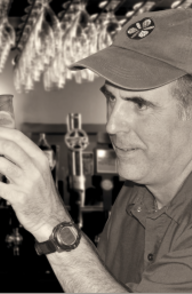Start 14-Day Trial Subscription
*No credit card required

Brewing With Gabe Fletcher of Anchorage Brewing Co.
BC: The original Anchorage Brewing Company was unique in my experience. It was a brewery built inside of an already existing brewpub.
Fletcher: Anchorage Brewing literally came to me in a dream. I woke up, grabbed a sheet of paper and started writing out a business plan. I said: ‘Wow, this could actually work.’ I drew the plans for this new building five years ago. I had everything written out, and then Greg Mills from the Snow Goose brewpub said ‘Why don’t you brew here?’ The idea made sense once the wheels started turning: He had all this extra room over there, and it would be a great starting point because I wouldn’t have to come up with all this extra capital.

Large oak foudres at Anchorage, where Gabe expertly ages his beers with wood.
BC: Do the large oak foudres you have add an additional layer of character or do they fundamentally change the beer in your opinion?
Fletcher: It’s a pretty dramatic difference. The beers seem to come out a bit softer. There’s a better ester profile. There are a lot more variables and it's more dangerous. It’s easy to ferment in wood one time and have it become pretty predictable. But wood continues to evolve over time, and you have to be on top of things or you will have bad batches. That's just part of the risk.
BC: Do you have any advice for homebrewers if they choose to brew on the wild side? Are there fundamental mistakes many make?
Fletcher: I wouldn’t start by putting wort outside and fermenting it. That can be tricky (and dangerous) if you're not careful. I’ve done primary Brett beers and secondary Brett beers, and I definitely prefer beers where the Brett was introduced into the secondary fermentation. I feel that you get much more complexity out of the beers that way. There are a few myths out there – like Brett can’t handle hops. Actually Brett is a hop's best friend. You can have a really hoppy beer and the Brett will keep the hops from oxidizing. The Galaxy White IPA, you can have it two years from now and the hops will die down but they won’t oxidize. The esters come up and the Brett is more forward, making it a different experience, but the hops still taste fresh because of the Brettanomyces. The Brett stays alive so much longer than regular saccharomyces yeast. Also, if you want to make a true wild beer don’t force carbonate it – it needs to be alive.




